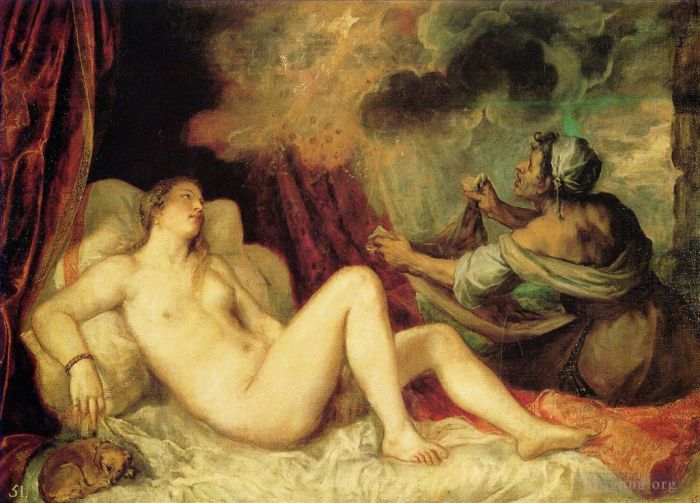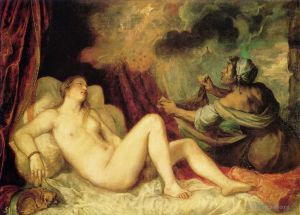Danaë
Titian
- Price: Price on Request
- Art Type: Oil Painting
- Size:
- English Comments: 0
- International Comments: 0
- Creating Date:
- Introduction and Works of Titian >>
Keywords:
Danaë
Work Overview
- Danaë
1544-46
The original version in Naples, 120 cm × 172 cm
National Museum of Capodimonte
The Venetian painter Titian and his workshop made at least six versions of the same composition showing Danaë (or Danaë and the Shower of Gold) between about 1544 and the 1560s. The scene is based on the mythological princess Danaë, as -very briefly- recounted by the Roman poet Ovid, and at greater length by Boccaccio. She was isolated in a bronze tower following a prophecy that her firstborn would eventually kill her father.[3] Although aware of the consequences, Danaë was seduced and became pregnant by Zeus (in Roman mythology Jupiter), who, inflamed by lust, descended from Mount Olympus to seduce her in the form of a shower of gold.
Titian and his workshop produced at least six versions of the painting, which vary to degrees. The major surviving versions are in Naples, London, Madrid, Vienna, Chicago, and St. Petersburg. The voluptuous figure of Danaë, with legs half spread, hardly changes, and was probably traced from a studio drawing or version.[4] Her bed and its hangings are another constant. Other elements vary considerably; the first version, now in Naples, was painted between 1544-46, and is the only one with a figure of Cupid at the right, rather than an old woman catching the shower of gold. She is a different figure at each appearance, though the pose in the Hermitage follows the Prado version. The small dog resting at Danaë's side in the Prado and Chicago versions is generally absent.
The works influenced the compositions of many artists including Rembrandt,[5] Anthony van Dyck and Gustav Klimt, who all painted versions of the scene. Giorgio Vasari recounts a visit with Michelangelo to Titian's studio, where they saw the original in progress. Michelangelo praised Titian's use of colour in the Madrid painting, though later, in private, he was critical of Titian's draftsmanship.
The first version was painted in both Rome and Venice for Cardinal Alessandro Farnese, whose grandfather then reigned as Pope Paul III. The papal nuncio in Venice saw it in progress, and in September 1544 wrote cheerfully to the cardinal comparing it to Titian's earlier nude, the Venus of Urbino. It is described as looking like "a Theatine nun", that would arouse even Cardinal Tommaso Badia. At least "Theatrine" is usually assumed to mean a nun, although it has been suggested that the term was also a "term of abuse to refer to any "ultra-conservative Catholic" killjoy".[19]
The features of Danaë, broadly retained in the later versions, are based on the cardinal's courtesan mistress Angela; Giulio Clovio had sent Titian a likeness from Rome for him to use.[20] It seems likely that it was intended originally simply as a portrait of Farnese's mistress, possibly loosely identified as Venus by the presence of the Cupid. The Council of Trent began in December 1545 as it was being finished, and the cardinal became worried about an overt display of his affair; even though few would see the paintings in his private apartments, word would no doubt get around. The face was slightly de-individualised, and either artist or patron had the idea of turning the painting into one of Danaë.[21]
It is the only major version where a Cupid stands at Danaë's feet, the other versions have an aged servant. Presumably once Titian introduced this in Philip II's version, he preferred it and used it thereafter. Danaë's bed seems to lie in an open loggia, or beside a large window. The base of a large classical column occupies the background of the centre of the painting, and to the right of that there is an elevated view of trees and distant hills, not very clearly defined. The settings of Titian's several versions of the Venus and Musician series, also centred on a reclining nude, are comparable. The other major Danaë versions all replace the large column with more red drapery, and (except for Chicago and St Petersburg) have an even less clearly depicted outside background, mainly of sky. The cloth over Danaë's thigh is also not seen again. The burst of light that showers coins and on which Danaë's heavy gaze falls is flanked by dark clouds that appear to be moving towards the centre of the canvas. They spill heavy rain, which falls parallel to Zeus's coins.[22]
This version passed by descent through the Farnese family to the royal collection in Naples, and is now in the National Museum of Capodimonte, Naples.
- Copyright Statement:
All the reproduction of any forms about this work unauthorized by Singing Palette including images, texts and so on will be deemed to be violating the Copyright Laws.
To cite this webpage, please link back here.
- >> English Comments
- >> Chinese Comments
- >> French Comments
- >> German Comments
- >>Report
- Noli me Tangere 1511
- Clarice Strozzi 1542
- The Rape of Europa
- Venus with a Mirror
- Federigo Gonzaga Duke of Mantua
- Portrait of a Woman calledLa Schiavona
- Vanitas 1515
- Violante
- Assumption of the Virgin
- Flora
- The fall of man 156nude
- Salome 1555
- Danaë
- Jupiter and Anthiope Pardo Venus
- Man with Gloves
- Portrait of Jacopo Strada
- Bacchus and Ariadne
- King Philip II
- Mary with the Christ Child
- The Bravo
- Madonna detail
- St Jerome
- Portrait of a Man 151The Met
- Entry of Mary into the temple 1534
- Saint Christopher
- Portrait of Marcantonio Trevisani
- Pieta
- Portrait of an Old Man Pietro Cardinal Bembo
- The Worship of Venus
- Profane Love or Vanity 1514
- Feast of the Gods
- Empress Isabel of Portugal
- Crowning with Thorns
- Venus and Adonis
- Self Portrait
- Sacred and Profane Love
- Portrait of a Man in a Red Cap
- The Emperor Charles V at Mühlberg (Equestrian Portrait of Charles V)
- Bacchanal 1523
- Woman in white 1555
- Christ Crowned with Thorns
- Venus Blindfolding Cupid nude
- Portrait of Pope Paul III
- Madonna with Saints and Members of the Pesaro Family detail1
- Saint Mark
- Salome 1512
- Venus with an Organist and Cupid (Venus and Musician or Venus with an Organist and a Dog)
- Pope Paul
- Annunciation
- The Last Supper
- Assumption detail
- Portrait of Count Antonio Porcia
- Saint John the Baptist
- Philipp II as Princedetail
- Venus of Urbino
- Tintoretto The Tribute M
- Suicide of Lucretia 1515
- Danae 154nude
- Portrait of Pietro Aretino
- Tintoretto Pope Alexander IV Presenting Jacopo Pesaro to St Peter
- Portrait of Ranuccio Farnese
- The Speech of Alfonso dAvalo 1540
- Portrait Ariosto
- Saint Mark Enthroned
- Pope Paul III and His Grandsons
- Portrait of Charles V Seated
- Portrait of Philip II
- The Gypsy Madonna
- The Three Ages of Man 1511
- Mater Dolorosa
- Titians daughter Lavinia 1560
- Philipp II as Prince
- Pesaro Madonna









 Singing Palette
Singing Palette